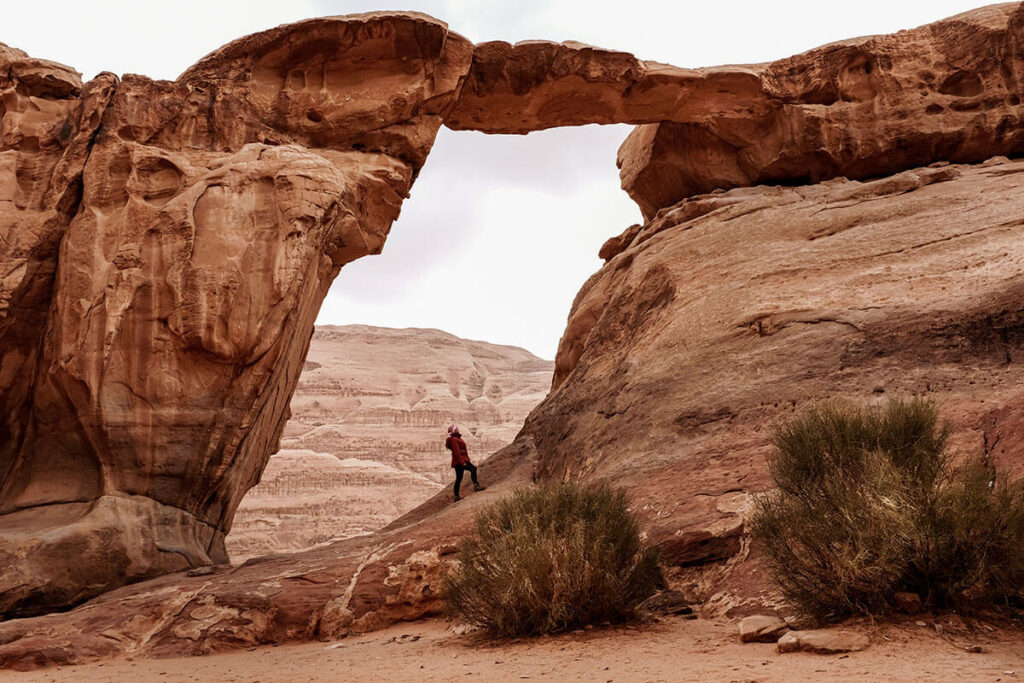Wadi Rum in Jordan may not be the largest desert, but it is considered one of the most beautiful deserts in the world. The moment you set foot in Wadi Rum, it becomes clear why. You’ll be continuously amazed by the changing colors, striking rock formations, soft rolling dunes and breathtaking views beneath magical skies. It’s no surprise that Wadi Rum has been the backdrop for numerous films and commercials. The whole place feels like one big movie set. Want to experience this desert in Jordan for yourself? Below, I’m sharing some Wadi Rum tips and an overview of the most beautiful sights in Wadi Rum.
Wadi Rum, World Heritage site in Jordan
Wadi Rum (Valley of the Moon) is often referred to as a desert, but it’s actually a vast river valley (wadi). It covers an area of 74,000 hectares, making it the largest wadi in Jordan. Wadi Rum features endless sand plains, dunes and rock formations that reach heights of up to 1,700 meters. The area lies 300 kilometers south of the capital Amman, 100 kilometers south of Petra and about 70 kilometers east of Aqaba.
Wadi Rum is often described as one big open-air museum. You’ll find many remnants of the Nabataeans here and even traces of the Thamudic people who lived in the area before them. Inscriptions and petroglyphs can be found in numerous locations. In total, around 25,000 drawings and 20,000 inscriptions have been discovered, most dating back to the Thamudic period. In addition to Nabataean and Thamudic markings, many Islamic and Arabic inscriptions are visible as well.
Thanks to its unique landscape, the wealth of inscriptions that reflect over 12,000 years of human settlement and interaction with nature, Wadi Rum was added to the UNESCO World Heritage List in 2011.
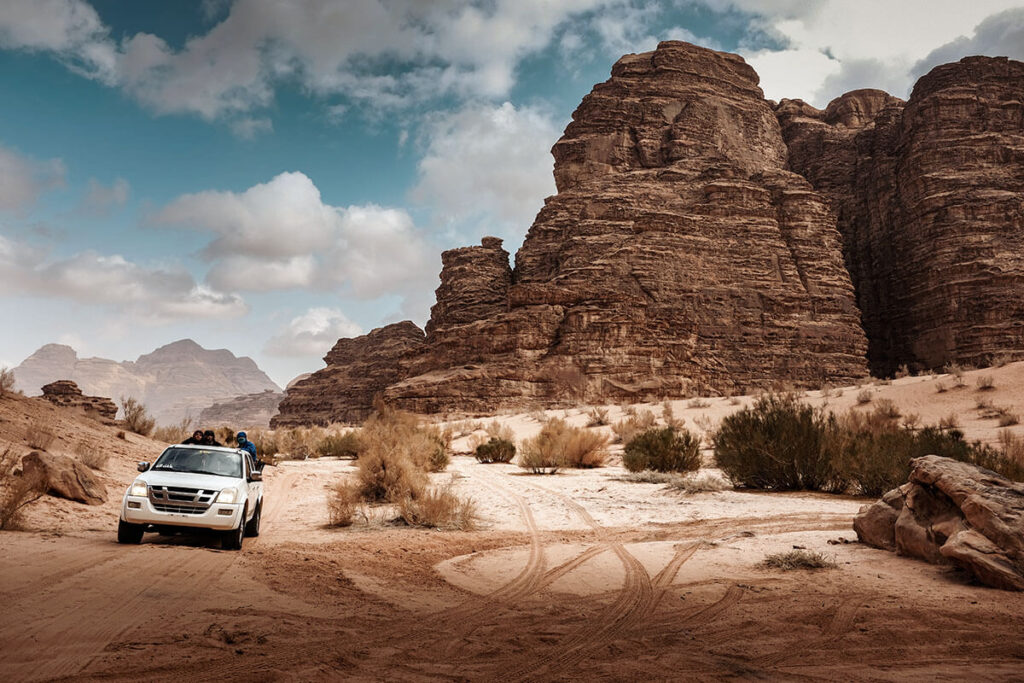
Lawrence of Arabia
The area also gained greater fame thanks to archaeologist Thomas Edward Lawrence, who stayed in the region in the early 1900s. When World War I broke out in 1914, he joined the military and fought against the Ottomans. The book he wrote during this period, Seven Pillars of Wisdom, was adapted into a film in 1962. The movie, Lawrence of Arabia, was largely filmed in Wadi Rum and went on to win seven Oscars. In addition to this classic, Wadi Rum has served as a filming location for many other movies, including The Martian, Rogue One: A Star Wars Story, Passion in the Desert, Red Planet, Prometheus, Star Wars: The Rise of Skywalker, The Last Days on Mars and The Face (BBC).
History of Wadi Rum: the Nabataeans
People have lived in this part of the Middle East for thousands of years; even long before the start of our calendar. Among them were the Nabataeans, skilled traders who moved goods along caravan routes throughout the region. The world-famous city of Petra was the Nabataean capital and an important crossroads for trade caravans. In addition to their trading prowess, the Nabataeans were also highly skilled in water management. In and around Wadi Rum, they built dams, underground pipelines and tunnels to store and transport water. Remains of these dam structures can still be seen in several locations. At the beginning of the 2nd century, the Nabataeans were displaced by the Romans, who also left many traces throughout the region.
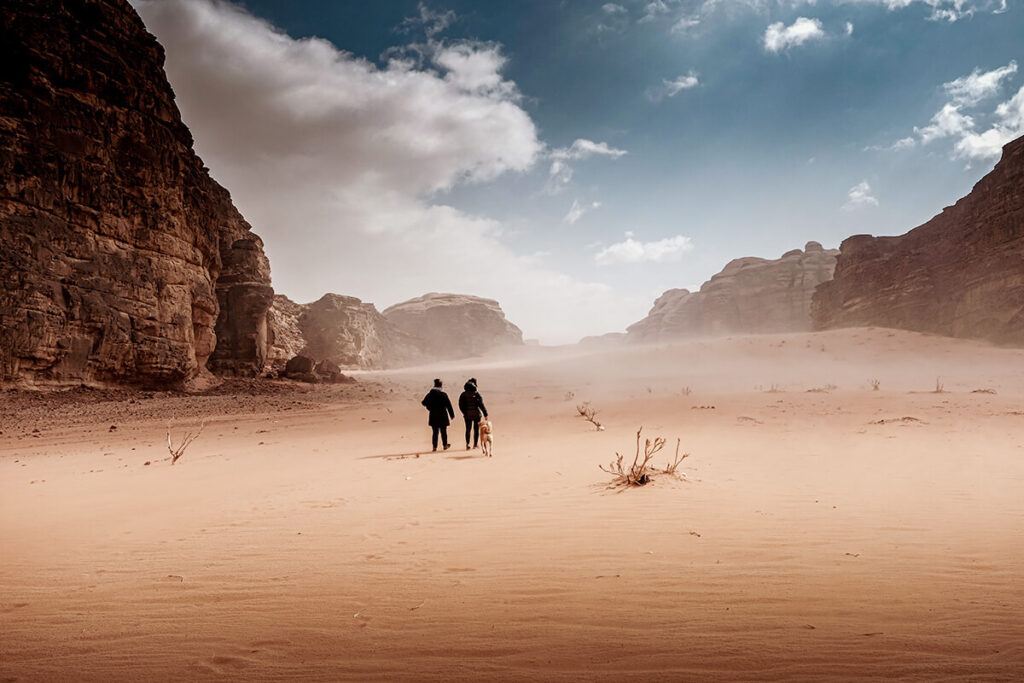
Visit Wadi Rum
You don’t necessarily need to spend the night in the desert to visit Wadi Rum. Many day tours are offered from places like Aqaba and Petra. Just an hour’s drive there, a few hours spent in the desert and then another hour back. However, for the full experience, I highly recommend spending the night in Wadi Rum. There are many different types of accommodation available, ranging from basic stays in a Bedouin tent with shared facilities to more luxurious options like a dome.
Sights in Wadi Rum
You’ll constantly be in awe in Wadi Rum; it’s one giant sight to behold. Still, a few places stand out above the rest. Many guides don’t follow a fixed route through the area, so you can indicate which spots you’d like to visit. Below is an overview of sights in Wadi Rum that you definitely shouldn’t miss.
Anfishiyyeh Inscriptions
As mentioned above, Wadi Rum is essentially one big open-air museum. Rock carvings and inscriptions can be found in several locations, so make sure to keep an eye out, as your guide might not point out every single one. Perhaps the best-preserved rock drawings can be found at Jabal Anfishiyyeh. On a flat rock wall at the side of this mountain, you’ll see many carvings known as the Anfishiyyeh inscriptions. Other places where you can find inscriptions and drawings include Rakhabat Canyon, Khazali Canyon, Lawrence’s Spring (Ain Abu Aineh) and Ain Shalaaleh.
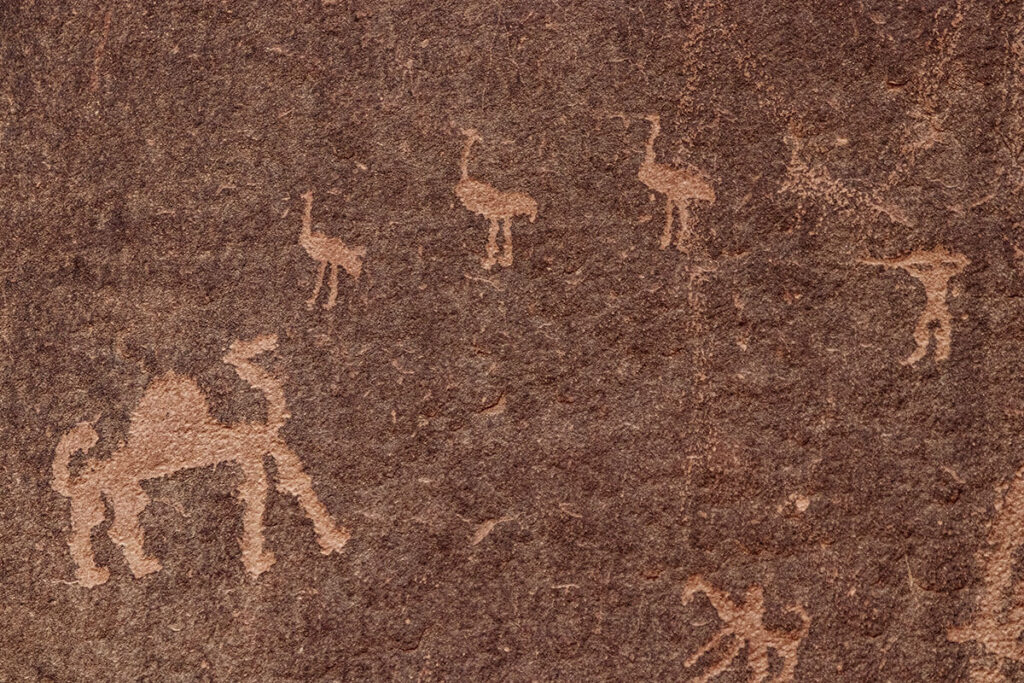
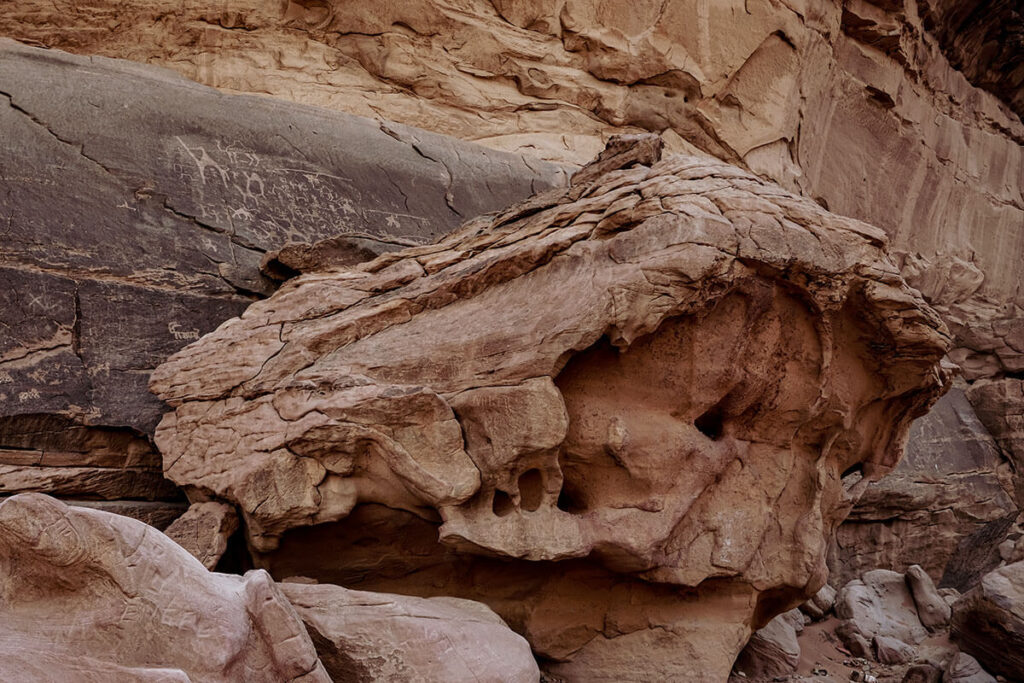
Um Fruth Rock Bridge
A true highlight in Wadi Rum is the Um Fruth Rock Bridge. This bridge stands 15 meters high and within 5 minutes, you can reach the top. The climb is steep, but the rough rock provides a good grip. Um Fruth Rock Bridge is sometimes confused with Burdah Rock Bridge (which is further down in this article), a bridge that is 20 meters higher and much more difficult to access.
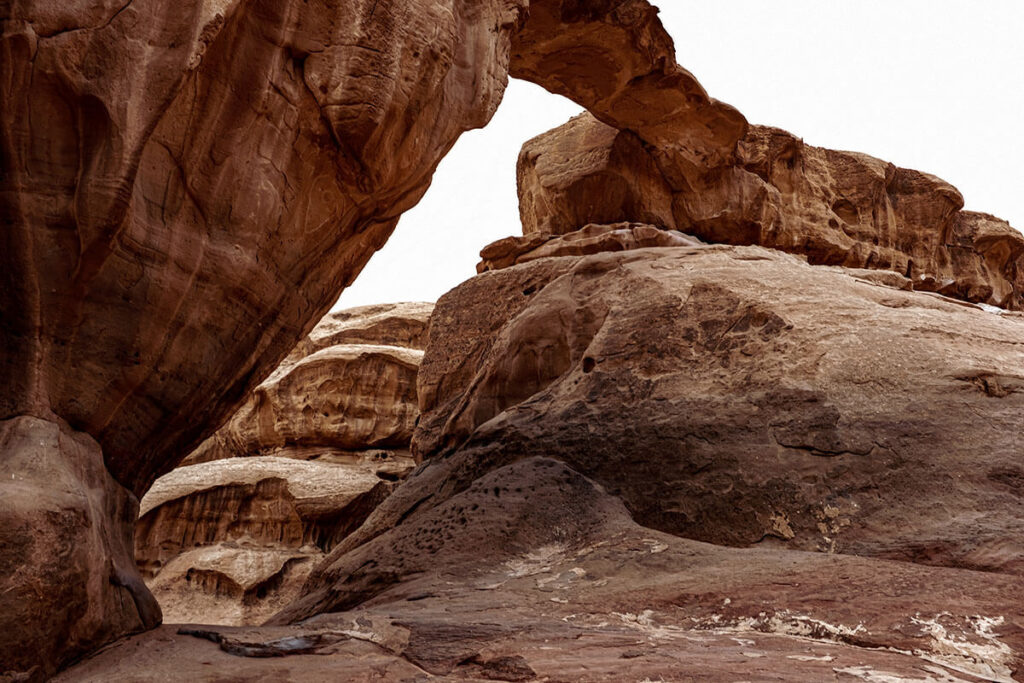
Lawrence’s House
It’s not certain whether Lawrence truly had a house here, but it is widely believed that he did. On the site where Lawrence’s House is thought to have stood, there is a large pile of stones, with a recognizable wall at the front. Still, it’s worth stopping by. You can climb up to the “stone men,” where you’ll be rewarded with a stunning view of the surrounding area.
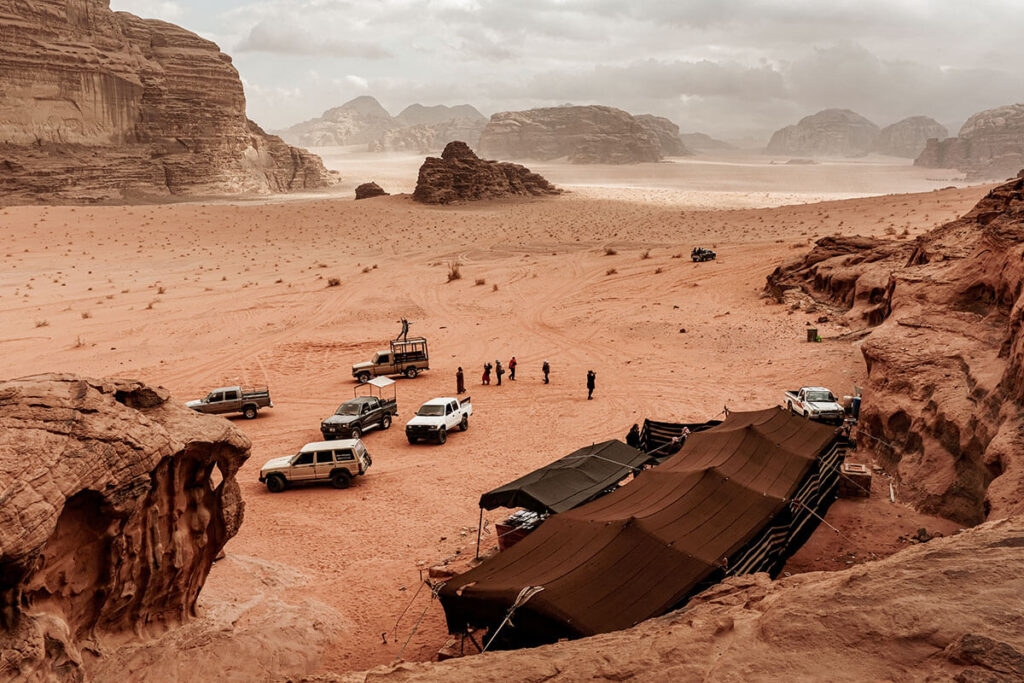
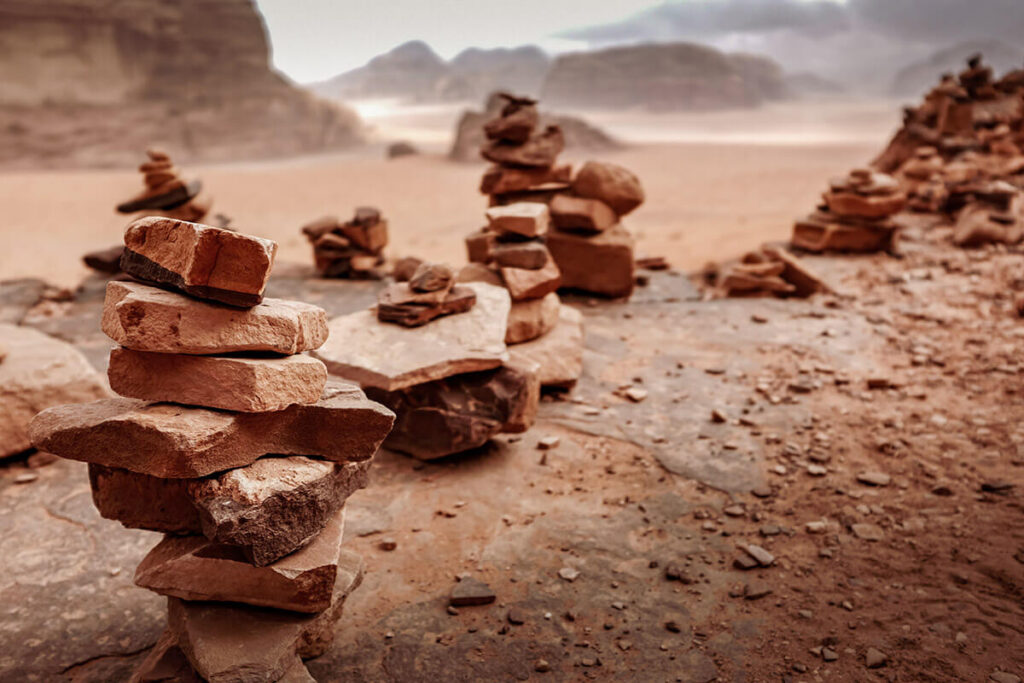
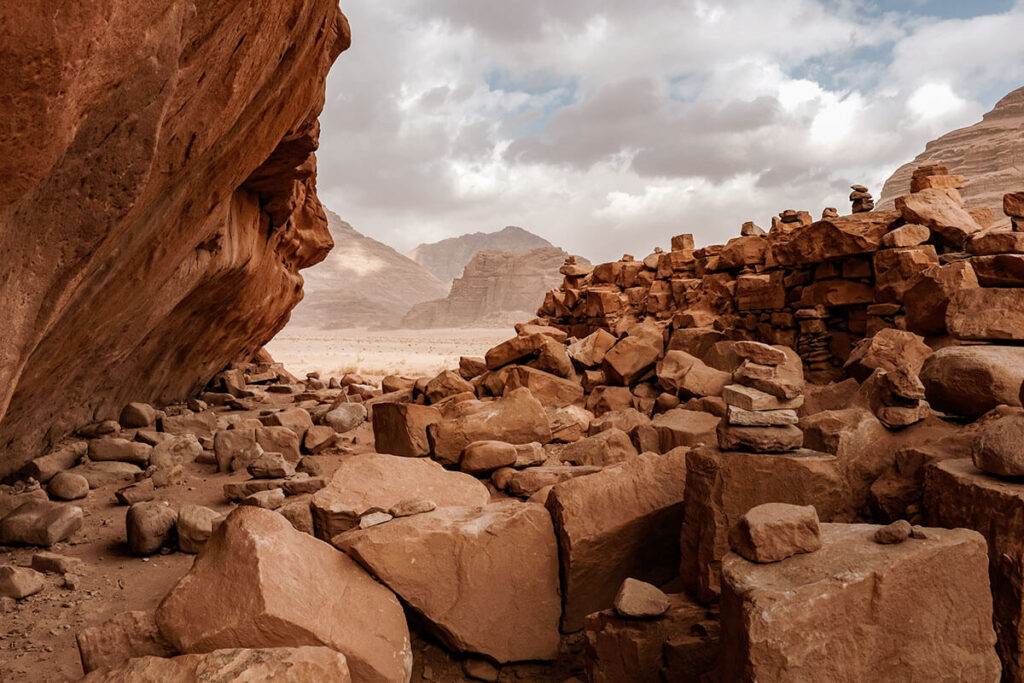
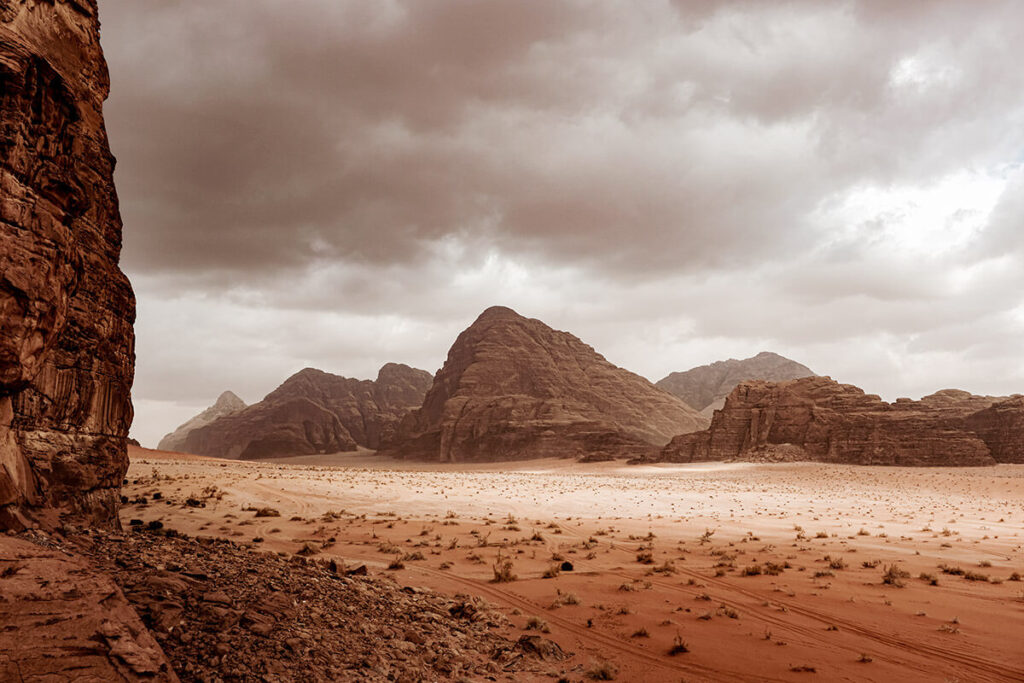
Seven Pillars of Wisdom
Opposite the Wadi Rum Visitor Center lies the striking mountain Jabal Al-Mazmar. Since the 1980s, this mountain has been called the Seven Pillars of Wisdom, named after the book by T.E. Lawrence. Some say that Lawrence chose the title for his book after seeing this mountain, as it reminded him of a biblical proverb: Wisdom has built her house; she has carved out her seven pillars.
Mushroom Rock
One of the most imaginative rock formations in Wadi Rum is Mushroom Rock. It’s hard to grasp how nature managed to create something like this. It almost looks like Asterix passed by and built a fun little tower, doesn’t it? Personally, I think this might be the most beautiful rock formation in Wadi Rum; especially when the sky is cloudy, it’s an absolute joy to photograph.
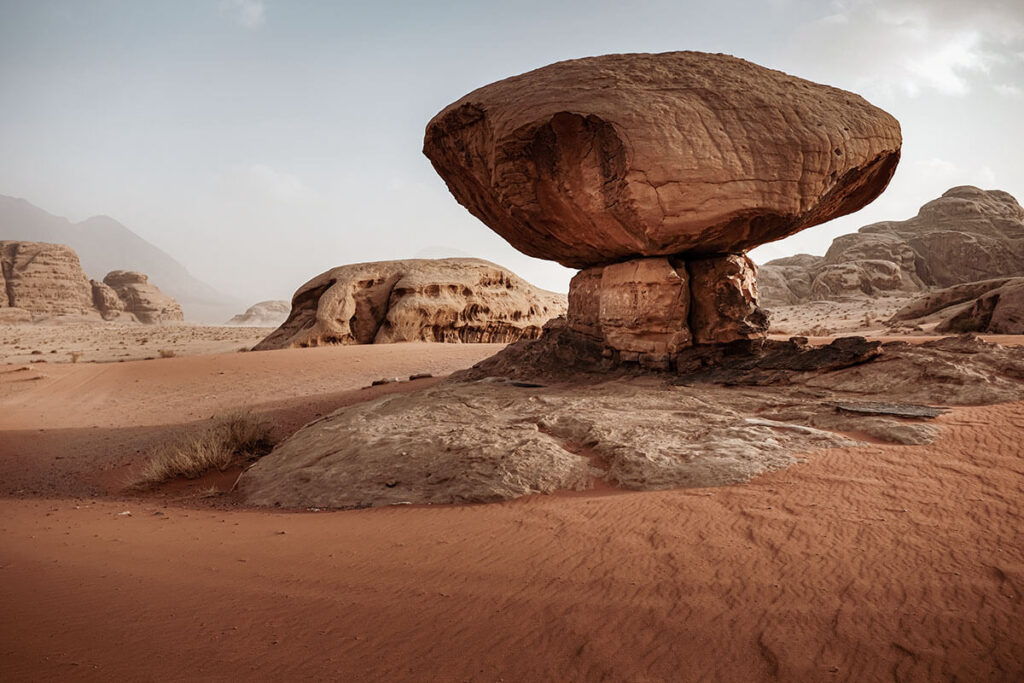
Red Sand Dunes
Another truly captivating spot in Wadi Rum is the Red Sand Dunes. There are several locations with red sand dunes. But this one is especially beautiful, mainly because of the breathtaking views you get from here. It’s easy to see why Wadi Rum is often one of the top choices when filmmakers are looking for Mars-like landscapes.

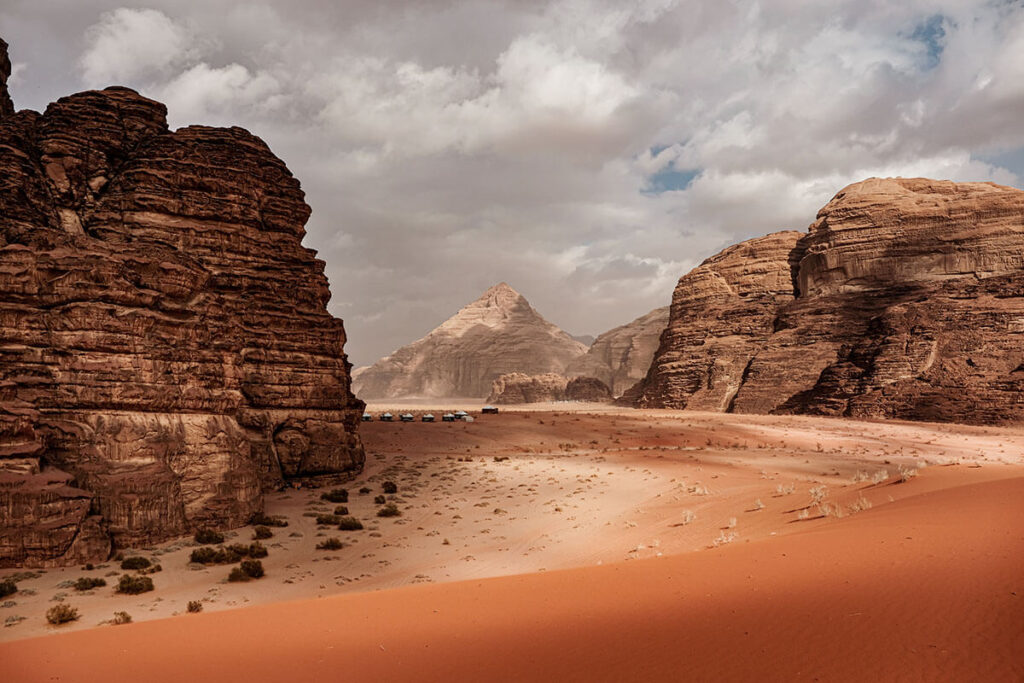
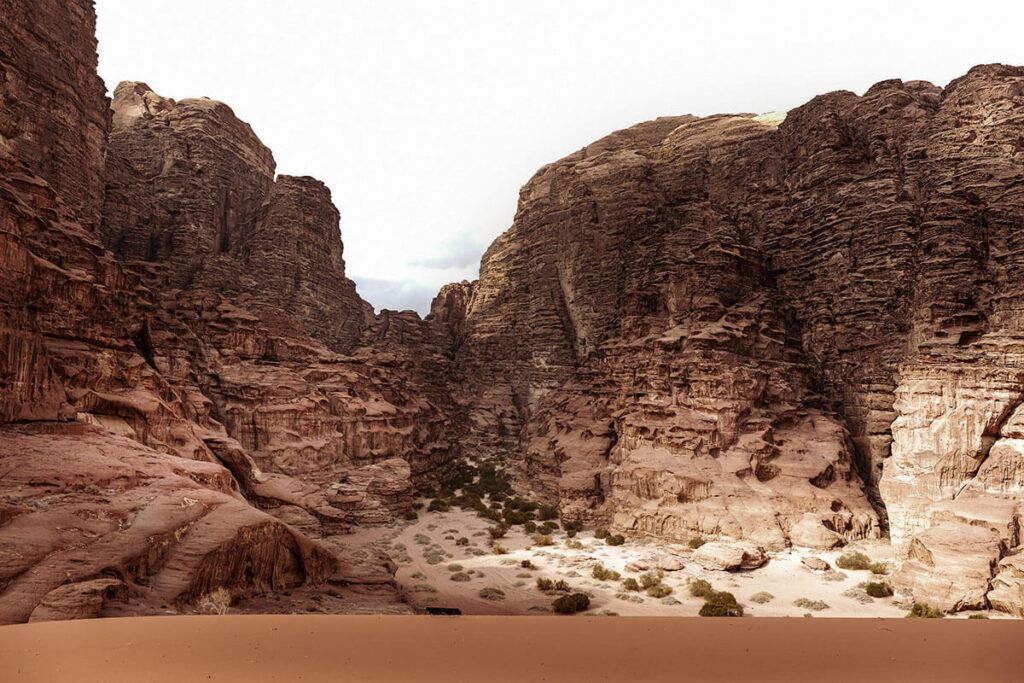
Siq Umm Tawaqi
Driving north along the beautiful Barrah Canyon, you’ll reach the stunning spot Siq Umm Tawaqi, also known as Busto de Lawrence de Arabia. At this location, images of Lawrence and Emir Abdullah have been carved into the rock. Some guides may try to convince you that the sculptures date back to Lawrence’s time, but they were actually created in the 1980s. Because of these carvings, the canyon is now often referred to as Siq Lawrence.
It’s well worth walking all the way into the canyon. The walls here are incredibly high and if you look closely, you’ll spot inscriptions and drawings. You’ll feel absolutely tiny! After this short walk, it’s nice to enjoy a glass of tea inside the Bedouin tent.



Burdah Rock Bridge / Jabal Burdah
Burdah Rock Bridge is the highest natural bridge in Jordan and it’s said to be the highest located natural bridge in the world at 35 meters. If you want to see the bridge up close, be prepared to set aside some time. The climb up and back down takes about three hours. Along the way, you’ll encounter some challenging sections, so a bit of experience with hiking and climbing definitely helps; as does not being afraid of heights!
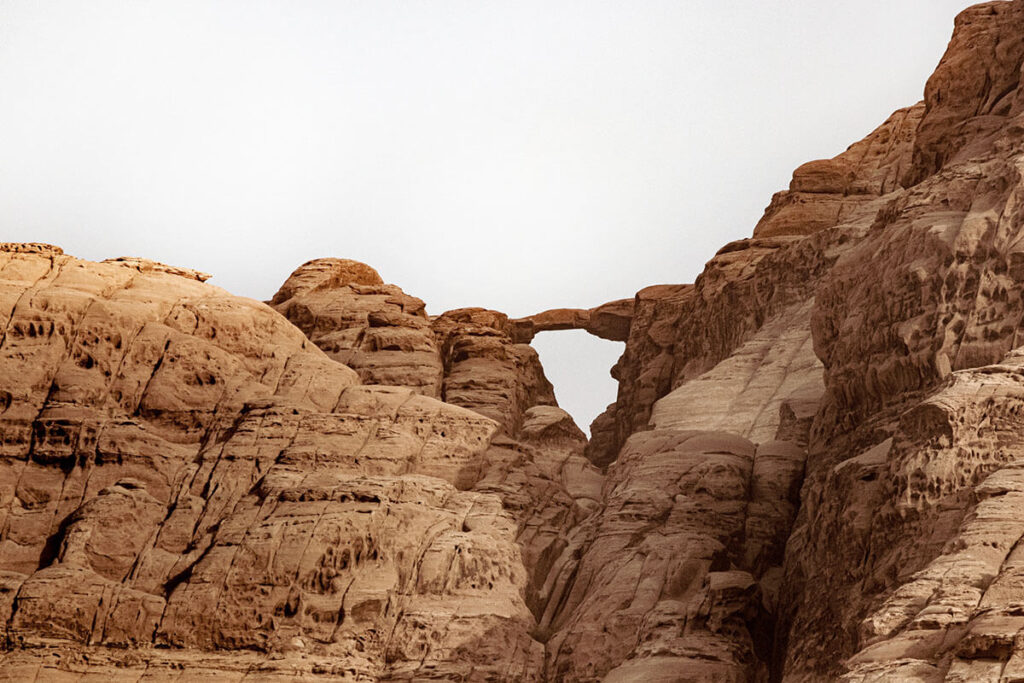
Bedouins With Camels
No desert is complete without camels! In Wadi Rum, you’ll occasionally come across Bedouins traveling through the desert with a herd of camels. Camels are incredibly curious, especially when they’re roaming freely. Drive up in a car and there’s a good chance they’ll come running toward you. It’s such a fun experience and makes for some great photos!
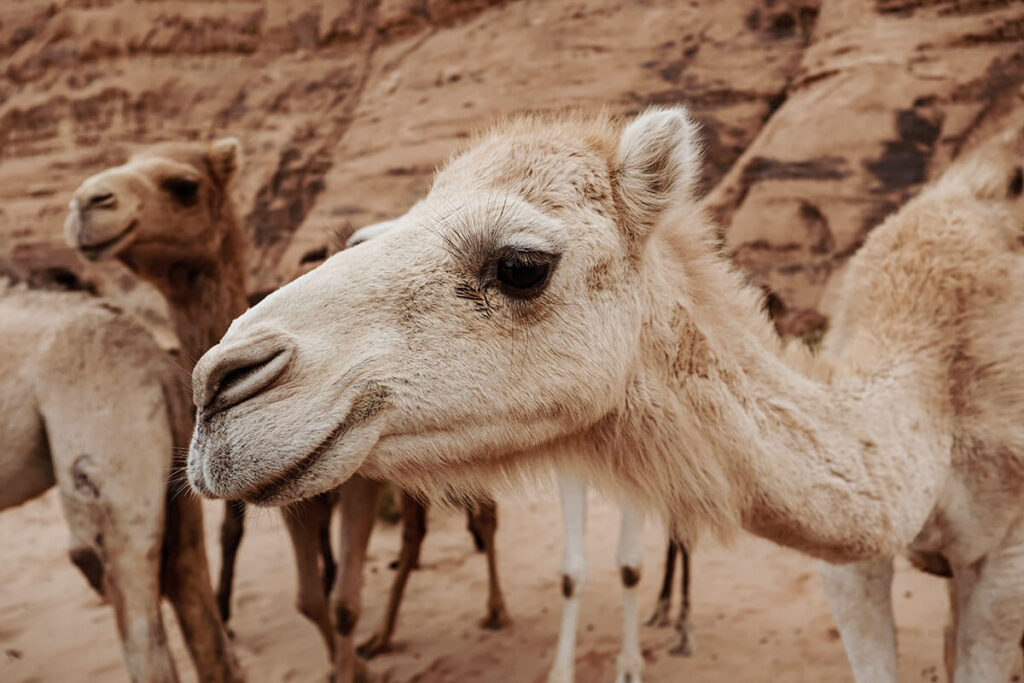
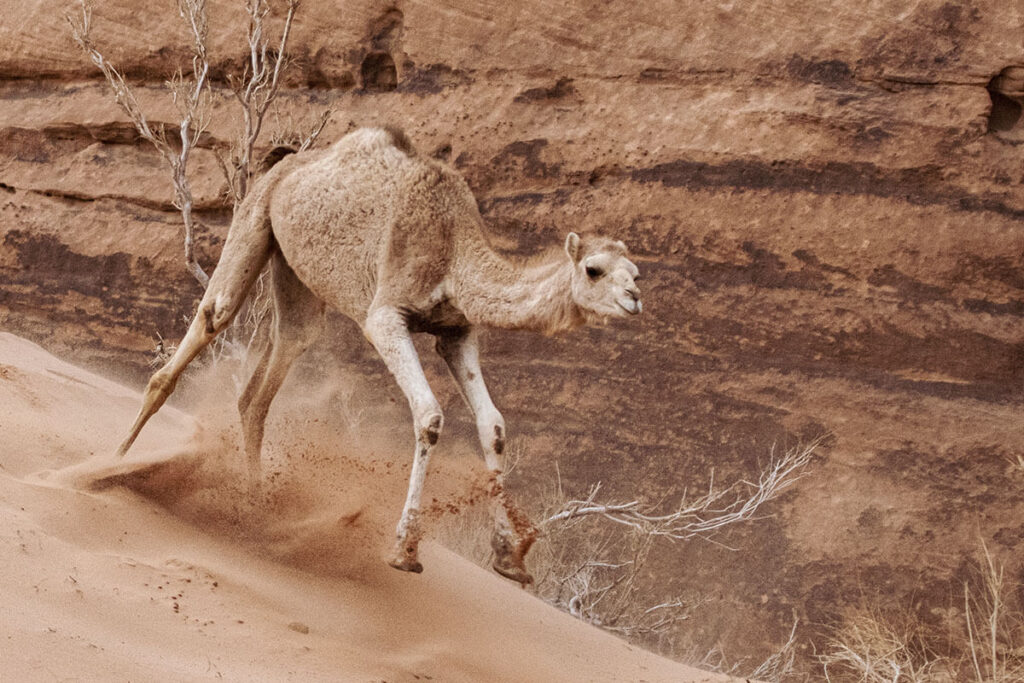
Rock Faces in Wadi Rum
There are so many unique rock formations in Wadi Rum that you’ll keep spotting something new. In several places, you can clearly recognize a face in the rocks. Sometimes you’ll instantly see what others see, while other times it takes a few glances before the shape reveals itself. Either way, the face-shaped rock formations are a real treat for people who love taking “kissing” photos.
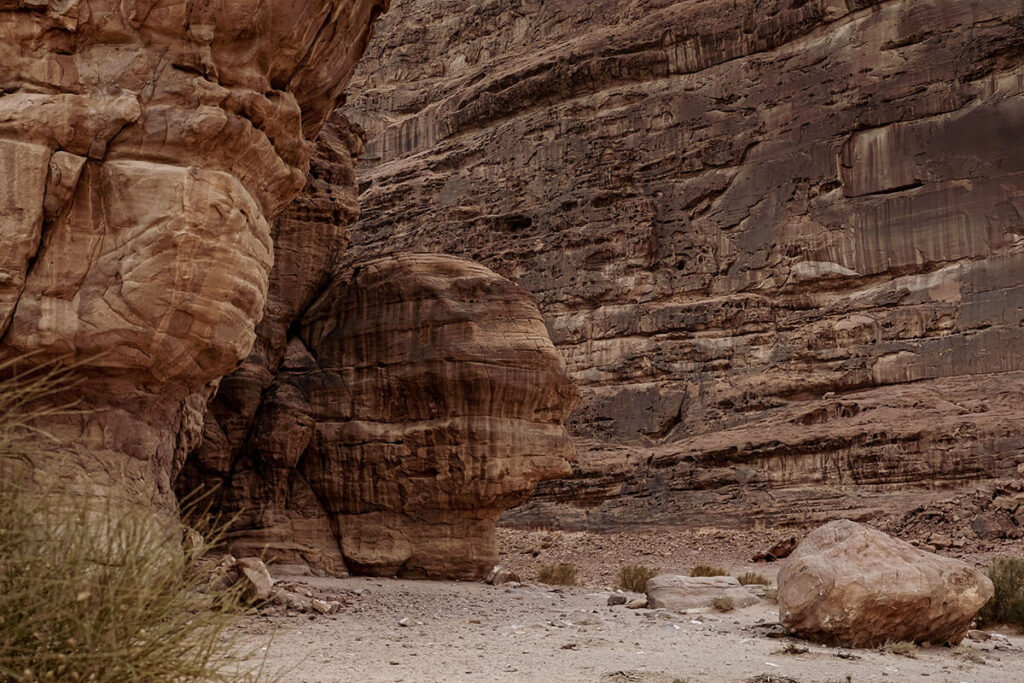
Khazali Canyon
You’ll find many canyons in Wadi Rum, ranging from wide to narrow and from short to long. Some are dead ends, while others allow you to walk from one canyon into another. Khazali Canyon can be entered for a short distance before you’ll need to climb to continue further. In the canyon walls, you can look for various inscriptions and ancient drawings.

Spending the night in Wadi Rum
You truly experience Wadi Rum when you spend the night there. It’s such a joy to sip tea with Bedouins by the campfire in the evening, witness a sky full of stars at night and then wake up to pull back your tent curtains and gaze endlessly into the desert.
I had the “bad luck” of waking up to see almost nothing of the desert due to strong winds—we could only see walls of sand rolling in. Still, I was happy with the overnight stay. Even though everything, including my camera gear, was covered in sand, it was an experience I wouldn’t have wanted to miss. And it gave me a chance to capture some very different photos.

Hasan Zawaideh Camp
I stayed at Hasan Zawaideh Camp, where you can choose between traditional Bedouin tents and “Martian” domes. I slept in a Bedouin tent with air conditioning, heating and a private bathroom: completely fine! It’s clear that places like this take a beating from the elements. The big temperature swings cause cracks in the walls and strong winds tear at the tent’s outer fabric. And sand… well, you’ll find it everywhere, even in your bed. But that’s just part of the experience; what else can you expect in a desert? Compared to the Seven Wonders Luxury Camp near Petra, this camp is a bit less fancy, but then again, it’s also a lot wilder here.
The outdoor area is nicely laid out and has a cozy vibe. During my January visit, it was way too windy to sit outside, but I can totally imagine how relaxed and inviting it must be in summer.
Breakfast, lunch and dinner were all great, with a buffet full of flavorful Jordanian dishes. On clear evenings, there’s a campfire where you can sip sage tea. The shisha pipes are popular too, available in all kinds of flavors. If it gets too cold or windy outside, there’s a warm and welcoming indoor space with a fire.
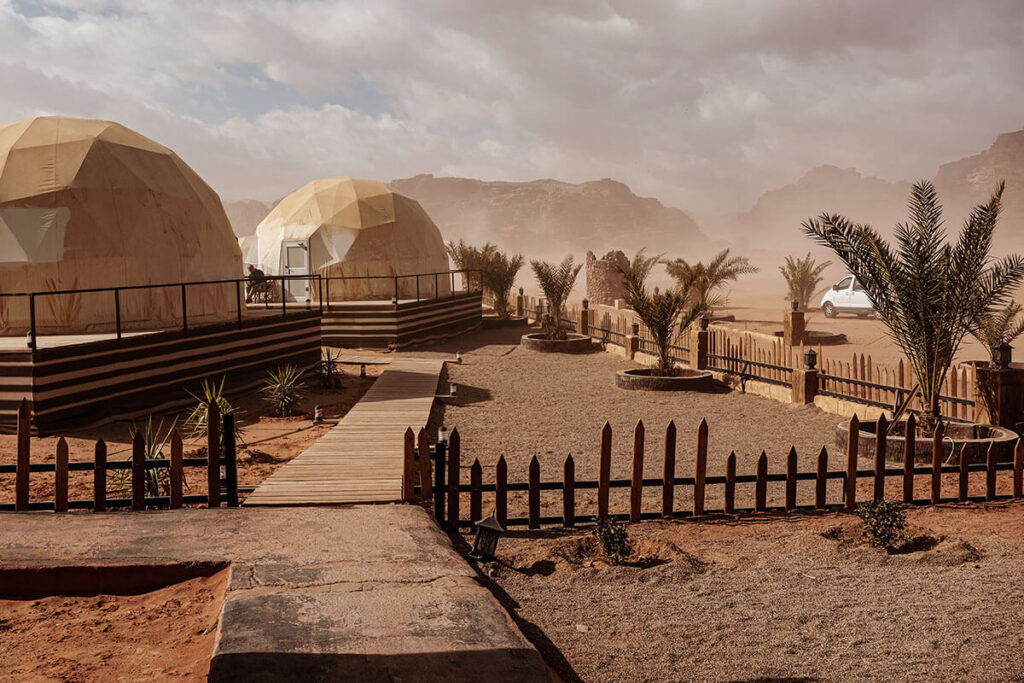

Wadi Rum in winter or summer?
Summers in Wadi Rum are hot and dry. During the day, temperatures hover around 30°C or higher and at night, it can cool down significantly. Spring and autumn are generally the best times to visit Wadi Rum. With temperatures around 25°C, it’s not too hot and the chance of rain is low. In winter, you’ll need a bit of luck. Average temperatures are around 14°C, though there can be occasional highs of up to 18°C. The weather can also swing the other way, sometimes it’s much colder for several days. At night in winter, temperatures can drop to freezing or below. Just a few days before my visit, Wadi Rum was covered in a layer of snow… yes, that can happen too!
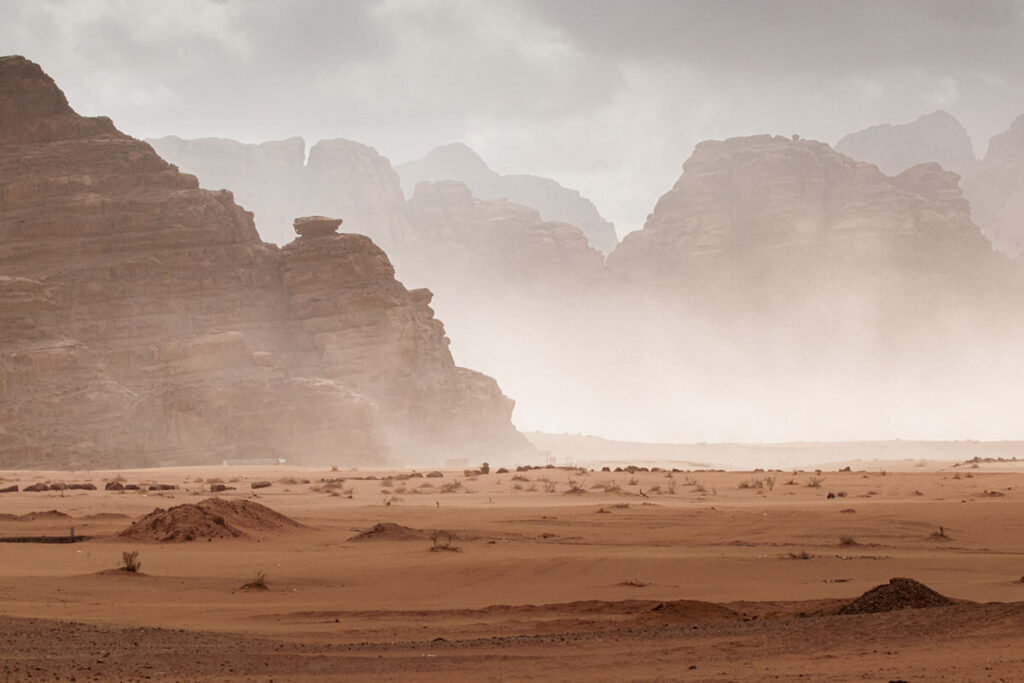
Tips for visiting Wadi Rum
The tips for visiting Wadi Rum depend a bit on the season. One thing you should always bring: plenty of water, sturdy shoes, sunscreen and something to cover your head. Even in winter, the sun is strong and on a clear day, you could easily burn your skin. Dress in layers, as temperature fluctuations in the desert can be quite extreme. If you’re visiting Wadi Rum in winter, it’s a good idea to bring a hat, thermals and gloves for the evenings.
Tips for a Wadi Rum tour
If you’re staying in a Bedouin camp in Wadi Rum itself, they can arrange a tour for you. Many camps even offer accommodation packages that include a tour, which is often the best deal. But even if you’ve booked your stay separately, you can easily arrange a tour with just one phone call to the camp’s reception. Have a rental car? Drive to the Wadi Rum Visitor Center to book a tour. You’ll pay the entry fee for Wadi Rum (5 dinars) here. If you have a Jordan Pass, your entry to Wadi Rum is included. You can explore Wadi Rum in a jeep, on foot or by camel. In some (often more luxurious) camps, you can even book a hot air balloon ride. Bring cash, as there are no ATMs in Wadi Rum and guides prefer to be paid in cash.
Tips for your camera in the desert
The sand in Wadi Rum is quite coarse, which causes fewer problems for cameras than Sahara sand. Still, it’s important to be cautious, especially when switching lenses. I’d also advise against using a camera with a gimbal (such as the DJI Osmo Pocket) if it’s very windy. Be careful when climbing with a camera around your neck. My camera bumped a few times against the rock walls and I’m glad I had a UV filter on the lens. Now, I only need to replace that filter, not the whole lens!
